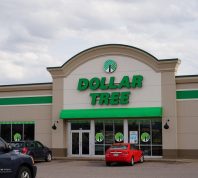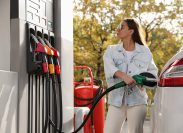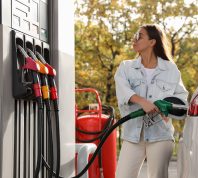This Is the Best Way to Increase Your Gas Mileage
To see your fuel efficiency go up, look down.

In 2007, according to U.S. Department of Energy statistics, the average price per gallon of regular unleaded gasoline was $3.16. In 2012, that figure jumped to $3.80. By 2015, it plummeted to $2.45. Right now, it's upwards of $3.05. So it's no wonder that, on J.D. Power & Associates's annual survey of which cars consumers shell out for and why, fuel efficiency has ranked among the top ten reasons for the past decade.
But if you're truly interested in maximizing your vehicle's fuel efficiency, the key is not in your wallet. It's in your tires.
Experts recommend that your tires stay inflated at a pressure level of 30 to 32 pounds per square inch (PSI), with a maximum of 35 PSI. If your tires clock in at a lower value than that, you're expending more gas than you would with proper pressure levels; since your tires are deflated, your vehicle has less grip on the ground, and the engine needs to work harder—in other words, use more fuel—to propel the car forward. By keeping your tires properly plump, the DOE's Office of Energy Efficiency and Renewable Energy estimates that you could increase your gas mileage by up to 3 percent. And yes, when it comes to fuel efficiency, 3 percent is a lot; every little thing matters.
So next time you're at the pump, put some air in your tires. Then, going forward, be sure to refill air every month or so—or if temperature precipitously drops in your region. A rule of thumb is that, for every ten degrees Fahrenheit the weather drops, your tires will lose about 1 PSI. So if you live in the Northeast, where lows and highs can regularly be up to 20ºF apart, no matter what time of year, your tires could be bleeding pressure like an open wound. And, if at all possible, fill your tires with nitrogen instead of standard-issue oxygen, since nitrogen seeps out at a slower rate. Not all gas stations offer nitrogen, but most repair shops do.
And then, to really get the most out of each mile, be sure you're doing all the run-of-the-mill stuff. That means steering clear of sudden acceleration and breaking, keeping your air conditioning off (except for on those seriously sticky days), and culling any excess weight—like, say, that set of dust-gathering golf clubs in your trunk. Finally, if there's anything wrong with your engine, be sure to get that fixed, stat. According to the DOE, something like a faulty oxygen sensor could be reducing your gas mileage by a staggering 40 percent.
But beyond all of that, the surest, most foolproof method for maximizing your fuel efficiency and gas mileage is to ditch the car and adopt a public transit commute. Better yet, take it from us: you can get a lot done on a bus or train. (However, if you're dead-set on driving yourself, don't miss these 3 Most Overlooked New Cars—Video.)
To discover more amazing secrets about living your best life, click here to sign up for our FREE daily newsletter!





















